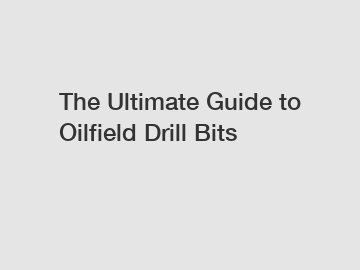The Ultimate Guide to Oilfield Drill Bits
The Ultimate Guide to Oilfield Drill Bits.
Oilfield drill bits are essential tools used in the petroleum industry for drilling into the earth's surface to extract oil and gas reserves. These bits play a crucial role in the efficiency and effectiveness of drilling operations. In this ultimate guide, we will explore the different types of drill bits used in the oilfield industry, their design and functionality, and the significance and impact they have on drilling operations.
Types of Oilfield Drill Bits.

There are three primary types of drill bits commonly used in the oilfield industry: roller cone bits, fixed cutter bits, and hybrid bits. Roller cone bits feature three cones with sharp teeth that crush and break the rock while drilling. Fixed cutter bits, on the other hand, have no moving parts and rely on diamond or tungsten carbide cutters to shear through the formation. Hybrid bits combine both roller cones and fixed cutters for enhanced performance in challenging drilling conditions.
The Design and Functionality of Drill Bits.
Drill bits are meticulously designed to withstand high levels of stress and heat during drilling operations. The bit's materials and construction are chosen based on the anticipated formation, drilling parameters, and environmental conditions. For example, roller cone bits are made with steel bodies and tungsten carbide inserts to ensure durability and efficient cutting action. Fixed cutter bits, on the other hand, utilize advanced diamond or polycrystalline diamond compact (PDC) cutters to provide exceptional abrasion resistance.
The Significance and Impact of Drill Bits.
The design and selection of drill bits have a significant impact on drilling efficiency, cost-effectiveness, and overall well performance. Proper drill bit selection can lead to faster drilling rates, reduced downtime, and increased drilling success rates. By analyzing the formation's properties and understanding the expected drilling conditions, engineers can choose the most suitable drill bit type, shape, and cutting structure to optimize drilling operations.
Furthermore, advancements in drill bit technology have revolutionized oilfield operations by enabling drilling in previously inaccessible areas. For example, the development of PDC cutters has allowed drilling in harder and more abrasive formations that were previously considered too challenging. This has led to increased exploration and production, as well as the discovery of new oil and gas reserves.
In conclusion, oilfield drill bits are vital tools that play a crucial role in the efficiency and success of drilling operations in the petroleum industry. By understanding the different types of drill bits, their design and functionality, and the significance and impact they have on drilling, engineers and operators can optimize drilling operations and enhance overall well performance. With continuous advancements in drill bit technology, the future of the oilfield industry looks promising, with increased exploration and production capabilities.
Are you interested in learning more about china hdd pdc bit, pdc vs roller cone bit, three cone bit manufacturer? Contact us today to secure an expert consultation!
104
0
0


Comments
All Comments (0)